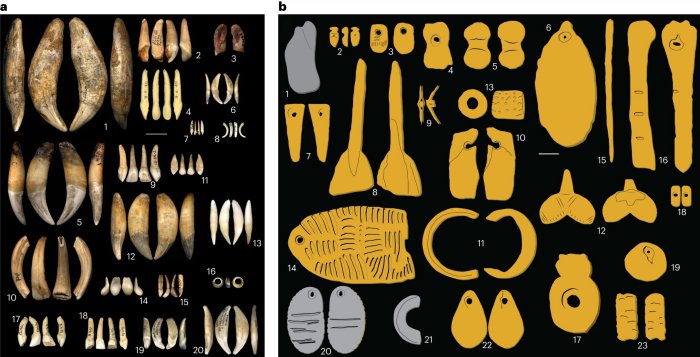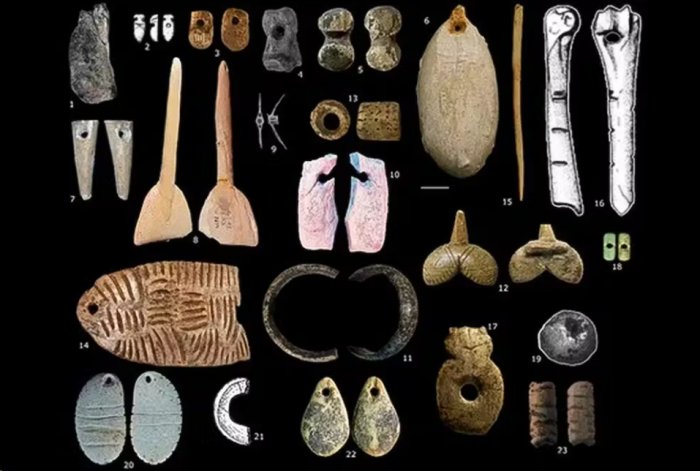Conny Waters – AncientPages.com – The activities of Stone Age people extended beyond hunting and seeking shelter. Prior research indicates that the practice of personal adornment has been a part of human culture for millennia.

People in Stone Age Europe appreciated personal ornaments. Credit: Adobe Stock – SpiralStone
In fact, individuals residing in Europe during the Stone Age created and wore exquisite ornaments. Through analysis of ancient jewelry from the Gravettian era, researchers have unearthed evidence suggesting that nine unique cultures existed in Europe between 34,000 to 24,000 years ago.
Gravettians Produced And Wore Ancient Jewelry
The Gravettians, a group of hunter-gatherers, inhabited Europe during an intensely cold phase of prehistory. The harsh climatic conditions significantly influenced their way of life. They were compelled to adapt due to the environmental changes brought about by the Pleniglacial period. During this era, West and Central Europe experienced extreme cold temperatures. Archaeologists typically identify two regional variants: The Western Gravettian, primarily known from cave sites in France, Spain, and Britain, and the Eastern Gravettian, found in Central Europe and Russia.
A group of anthropologists from Université Bordeaux conducted an in-depth study on the jewelry used by the Gravettians. Clearly, these hunter-gatherers, who were known to dress in animal skins, also valued personal accessories that they attached to their clothing and limbs or directly onto their skin. These adornments comprised a variety of materials such as animal teeth, bones, ivory, stones, shells, amber, and wood. Some of these items were worn as is, while others underwent modifications like carving or drilling holes for threading purposes.
Personal Ancient Ornaments Reveal Nine Distinct Cultural Groups Among The Gravettians
By analyzing hundreds of ornamentations and searching for patterns, the researchers pinpointed the unique attributes of the Gravettians’ adornments, enabling them to differentiate between nine distinct cultural groups within these hunter-gatherers.

Material used for Gravettian personal ornaments. a, Types of teeth used as ornaments identified at occupation and burial sites attributed to the Gravettian. 1, bear canine; 2, bear incisor; 3, bovid incisor; 4, European elk canine (Collection PACEA); 5, Felis canine; 6, fox canine; 7, fox incisor; 8, hare tooth (incisor) (Collection PACEA); 9, herbivore incisor; 10, horse incisor; 11, human tooth (canine); 12, hyena canine; 13, lynx canine; 14, red deer vestigial canine; 15, red deer incisor; 16, Sparus aurata tooth; 17, steppe bison canine (Collection PACEA); 18, steppe bison incisor (Collection PACEA); 19, wolf canine; 20, wolf incisor. Scale bar, 2 cm. b, Shaped ornaments and modified bones identified at occupation and burial sites attributed to the Gravettian. Scale bar, 1 cm. Credit: Nature Human Behaviour (2024). DOI: 10.1038/s41562-023-01803-6
The researchers identified consistent variations between groups residing in different regions. For instance, they discovered that individuals living in present-day Eastern Europe preferred white items like ivory and teeth. In contrast, those residing across the Alps were more attracted to brightly colored objects such as stones and shells. These differences were so significant that the team could distinguish nine unique cultural groups based on these preferences.
“Our results are consistent with the view that when choosing their personal ornaments, Gravettian hunter-gatherers followed, at least to some extent, conventions dictated by their sense of belonging to a cultural group and that slightly permeable cultural boundaries existed between groups as supported by our modeling results,” the researchers write in their study.

Stone Age people used a variety of materials for decoration. Particularly popular were the teeth of bears (1), foxes (6 and 7), and red deer (14 and 15). Credit: Nature Human Behaviour (2024). DOI: 10.1038/s41562-023-01803-6
“Human history is complex and multifaceted, extending well beyond the simple interaction of genes and ecology. We have demonstrated here, through the multivariate analysis of Gravettian personal ornaments and simulations modelling the impact of distance on cultural traits, that the sense of belonging felt by all humans today is deeply rooted in our shared history and played an important role in determining how Gravettian people adorned themselves.
See also: More Archaeology News
On a larger scale, our study identified nine distinct geographic subgroups in the Gravettian who wore different personal ornaments in both life and death. The results obtained for occupation and burial sites demonstrate that it is paramount that site function is taken into account in future research.
Comparison of our results with those of genomic studies has shown that symbolic material culture can reveal patterns not detectable by palaeogenomics. Integrating personal ornament and biological data from other Palaeolithic cultures will therefore help to elucidate the complex narrative of the earliest humans in Europe,” the scientists concluded.
The study was published in Nature Human Behaviour
Written by Conny Waters – AncientPages.com Staff Writer





